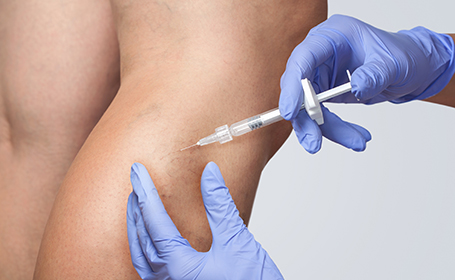
The benefits of varicose veins treatment
If varicose veins are causing you pain or affecting your confidence, a removal treatment could be the best solution. We take a look at some of the treatment options available, and consultant vascular surgeon and leading venous expert Mr Michael Gaunt shares his advice.
Removal treatment using modern techniques can be a simple and highly effective procedure. By removing the vein, the uncomfortable symptoms should significantly reduce. And given that the newest treatments require minimal incisions and injections, most patients experience little to no scarring, bruising or pain after the procedure.
Varicose veins are caused by weaknesses in veins' valves which prevent blood flowing properly between each of the vessels.

What causes varicose veins?
"Varicose veins are caused by weaknesses in veins' valves which prevent blood flowing properly between each of the vessels," explains Mr Michael Gaunt, a consultant vascular surgeon at St Edmunds Hospital. "If a one-way valve fails to let the blood through efficiently, the blood gets stored in the veins near the surface of the skin. This makes the vein expand, causing it to twist and protrude."
He continues: "They typically occur in people's legs because the blood vessels are under more pressure from walking, standing and sitting for long periods. Both women and men can develop varicose veins and they are very common. In fact, up to 20 percent of the population has varicose veins.
"Thread veins, also known as spider veins or reticular veins, are often mistaken as varicose. These veins are a result of daily wear and tear on delicate skin and appear as fine red or purple lines. Like for varicose veins, the modern treatments for thread veins are simple and effective."
Are varicose veins dangerous?
Whether varicose veins are dangerous depends on how bad they become. Varicose veins cause a variety of problems from being unsightly to causing an ulcer in your lower leg. If you develop an ulcer, this can be both dangerous and unpleasant. Ulcers are often painful and take time and effort to heal. Fortunately, it takes a long time for varicose veins to become severe enough to cause an ulcer. This means there are opportunities to prevent an ulcer from forming.
Varicose veins can also cause a condition called thrombophlebitis, where a clot develops in your superficial veins (a vein near the surface of your skin). This can cause soreness that can last for about a week. But it can spread to the deep vein system and lead to deep vein thrombosis (DVT), which can be a dangerous condition.
However, the majority of varicose veins won't be problematic or dangerous. Typically, people choose to have treatment because their veins are unsightly or uncomfortable.
How are varicose veins treated?

"EVLT uses a laser to heat and ultimately destroy the vein, leaving the body to dispose of the dead tissue naturally. Discolouration, bruising and tightness might occur after the treatment, but this should settle within a few days. The success rate of endovenous laser treatment is very high - around 98% of patients experience complete eradication of the incompetent veins after five years.
"ClariVein® uses an instrument that is inserted into the vein. It then rotates, destroying the inside of the vein, and releases a chemical to close the vessel. The combination of rotation and chemical kills the vein, which is broken down naturally by the body. Without the use of a laser, this treatment poses no risk of nerve damage, increased internal leg pressure or thermal damage. It is proving to be a particularly effective treatment and results suggest that 96% of patients had successful vein closure within one year."
Benefits of treatment
Endovenous Laser and ClariVein® treatments are associated with very good, long-term results. Patients typically experience a significantly reduced amount of pain and discomfort and the veins begin to reduce in size on their own. It is a permanent solution to the existing varicose veins by removing their cause, but it doesn't prevent new ones from occurring from other problem veins.
As they require minimal injections and incision, these treatments are usually virtually painless and leave little to no scarring or bruising.
A number of different factors can cause thread veins, including hormones and hereditary factors.
Treatment of thread veins
"A number of different factors can cause thread veins, including hormones and hereditary factors," says Mr Gaunt.
"However, they could also signify that a person has varicose veins that need treating separately. If a person has underlying varicose veins, the thread vein treatment will not be successful. Therefore, a full venous assessment is essential before treatment of thread veins can take place."
A simple removal procedure is used to treat thread veins. Both injection micro-sclerotherapy and VeinWave therapy are considered very effective.
Injection micro sclerotherapy involves injecting a chemical into the vein so they close and subsequently disappear. A compression dressing is then applied to improve circulation for approximately 48 hours after the treatment.
VeinWave therapy passes a pulse of electrical energy into the thread vein. This destroys the vessel and the body naturally eradicates the tissue. VeinWave therapy is usually used to treat facial red veins.
"Patients can experience swelling or bruising after both of these treatments, but this should decrease within a few weeks and the veins should permanently disappear," says Mr Gaunt.
Getting treatment
If you are considering having treatment for varicose veins or thread veins, you can arrange a consultation to assess your condition and discuss next steps. We have a large network of vascular surgeons across our 50+ UK hospitals and clinics, so you're never far from an experienced varicose veins specialist.

Tags
How do I book an appointment?
If you're concerned about symptoms you're experiencing or require further information on this subject, talk to a GP or see an expert consultant at your local Circle Hospital.